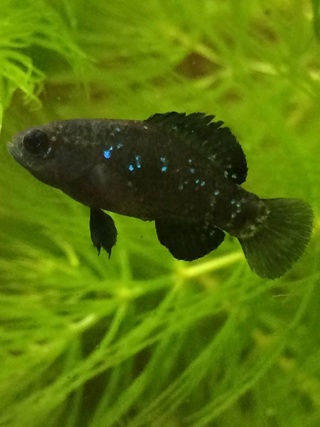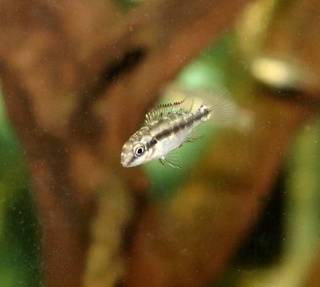Java Moss (Taxiphyllum Barbieri)
3 posters
:: Freshwater :: Plants :: Plant Profiles
Page 1 of 1
 Java Moss (Taxiphyllum Barbieri)
Java Moss (Taxiphyllum Barbieri)
Java moss has its origin in Asia and India. It has become a very popular plant due to its hardiness and quality as a hiding place for fry. It does not hurt that it is decorative, fast growing and very versatile either. Java moss does not need to be planted and can be attached to almost any surface or you can keep it free floating. Java moss can be very decorative if attached to roots or stones.
When you first introduce it to your aquarium attach the portions of moss to their growing place. This can be done by using a piece of fishing line, thread or a rubber band. The java moss will then attach itself to the surface and after a while they are able to keep themselves attached and the rubber band/fishing line can be removed. The moss grows fast and creates good hiding places for fry.
You can propagate your moss by cutting it and attaching the new parts on other places. It often propagate fast in an aquarium when pieces of the moss that have loosen attach themselves in other places in the aquarium and starts to grow.
Java moss accepts most water conditions as long as the water is clean but prefers a pH of 5.8-8.0 and a temperature of 18-30 degrees Celsius. You should make sure that you don’t get algae growing on your java moss as to much algae could kill it. Also tank needs to be very clean as particles that get stuck in the moss can damage it also. Java moss prefers low to medium light.
On of the main usages of java moss is to protect fry and eggs when breeding. It is excellent for spawning fish. The advantages of java moss is that egg eating fishes can’t get to those eggs that falls into the java moss which is giving the eggs a chance to develop. Another advantage is that infusoria life in the moss serves as food for the fry the first few days. In the end it is perfect for permanent breeding aquariums.
Some quick tips: if it is attached to rock or driftwood tap a gravel vac on top of it suck out debris stuck in to keep it clean and healthy. But don't drag the vac across it as you can damage the plant. If it is free floating remove it from the tank from time to time and gently rinse it out in a bucket of clean tank water to rid of debris. Your plant will thank you for the cleaning. A very tough and enjoyable moss to have.
Search for other Low Light Plants species using the hash tag link #LowLightPlants

When you first introduce it to your aquarium attach the portions of moss to their growing place. This can be done by using a piece of fishing line, thread or a rubber band. The java moss will then attach itself to the surface and after a while they are able to keep themselves attached and the rubber band/fishing line can be removed. The moss grows fast and creates good hiding places for fry.
You can propagate your moss by cutting it and attaching the new parts on other places. It often propagate fast in an aquarium when pieces of the moss that have loosen attach themselves in other places in the aquarium and starts to grow.
Java moss accepts most water conditions as long as the water is clean but prefers a pH of 5.8-8.0 and a temperature of 18-30 degrees Celsius. You should make sure that you don’t get algae growing on your java moss as to much algae could kill it. Also tank needs to be very clean as particles that get stuck in the moss can damage it also. Java moss prefers low to medium light.
On of the main usages of java moss is to protect fry and eggs when breeding. It is excellent for spawning fish. The advantages of java moss is that egg eating fishes can’t get to those eggs that falls into the java moss which is giving the eggs a chance to develop. Another advantage is that infusoria life in the moss serves as food for the fry the first few days. In the end it is perfect for permanent breeding aquariums.
Some quick tips: if it is attached to rock or driftwood tap a gravel vac on top of it suck out debris stuck in to keep it clean and healthy. But don't drag the vac across it as you can damage the plant. If it is free floating remove it from the tank from time to time and gently rinse it out in a bucket of clean tank water to rid of debris. Your plant will thank you for the cleaning. A very tough and enjoyable moss to have.
Search for other Low Light Plants species using the hash tag link #LowLightPlants

Last edited by guppyguy on Thu Jan 29, 2015 4:03 pm; edited 1 time in total

guppyguy- Moderator
- Posts : 2165
Join date : 2014-01-24
Location : Wheatley, ON
 Re: Java Moss (Taxiphyllum Barbieri)
Re: Java Moss (Taxiphyllum Barbieri)
These are my main plant. I use them in virtually every tank. In tanks without aeration and filtering I use this plant as the go-to natural aerator. For gravid female livebearers this is the best tool for save fry; even better than breeder boxes. Every hobbyist should have this plant floating around for general purpose use !

alexmtl- Veteran Member

- Posts : 3274
Join date : 2013-09-07
Location : Montreal Quebec
 Re: Java Moss (Taxiphyllum Barbieri)
Re: Java Moss (Taxiphyllum Barbieri)
alexmtl wrote:These are my main plant. I use them in virtually every tank. In tanks without aeration and filtering I use this plant as the go-to natural aerator. For gravid female livebearers this is the best tool for save fry; even better than breeder boxes. Every hobbyist should have this plant floating around for general purpose use !
I 100% agree. I always have java moss around.

guppyguy- Moderator
- Posts : 2165
Join date : 2014-01-24
Location : Wheatley, ON
 Re: Java Moss (Taxiphyllum Barbieri)
Re: Java Moss (Taxiphyllum Barbieri)
Java moss is superb.
In fact. I'll message you so I can get more..
In fact. I'll message you so I can get more..
 Re: Java Moss (Taxiphyllum Barbieri)
Re: Java Moss (Taxiphyllum Barbieri)
Plant profile video on Java and Christmas Moss.

guppyguy- Moderator
- Posts : 2165
Join date : 2014-01-24
Location : Wheatley, ON
 Similar topics
Similar topics» Problem with java moss
» Java Fern (Microsorium Pteropus)
» Sphagnum Peat Moss
» Christmas Moss (Vesicularia montagnei)
» Peat moss substrate for amazonian tank?
» Java Fern (Microsorium Pteropus)
» Sphagnum Peat Moss
» Christmas Moss (Vesicularia montagnei)
» Peat moss substrate for amazonian tank?
:: Freshwater :: Plants :: Plant Profiles
Page 1 of 1
Permissions in this forum:
You cannot reply to topics in this forum
 Alexmtl
Alexmtl


» Anyone still around? Need help transporting fish
» Stocking suggestions
» New Tank Purchase
» 3 Gallon Tetra half moon tank
» White floaty stuff in gold fish tank
» Ammonia in tap water
» Need advice for beginner with fresh water tank
» Fluval FX5 hose size?
» smart fish, dumb fish, pink fish...um, what rhymes with dumb?
» Is K&E sandblasting sand same as Black diamond?
» What the...is that a leak? NOOOOOOOOOOO!!!!! (a comedy of horrors...)
» Air stones and the noise they make
» aquatic medications
» film like stuff on the water surface of shark tank
» Articles on swordtail behaviour and fathead minnows
» Lets see your predators!
» Humane way to PTS a shark
» My tanks (Introducing myself)
» Build your own aquarium